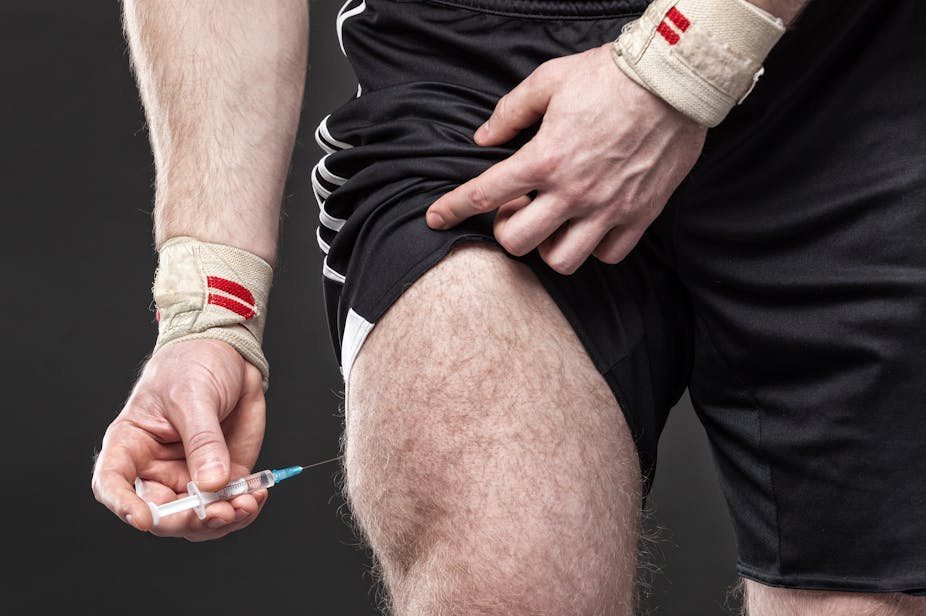What would sport be like if performance-enhancing drugs were allowed? How fast could the fastest athletes run? How high could they jump? How heavy could they lift? The Enhanced Games seeks to answer these questions by removing all restrictions on doping.
In lifting the ban on performance-enhancing drugs, the Enhanced Games challenges a core tenet of modern sports ethics – that sport should be doping-free.
When the first Enhanced Games takes place in December 2024, athletes in its five categories of competition – track and field, swimming, weightlifting, gymnastics, and combat sports – will be allowed to ingest whatever substance they wish to improve their performance.
There will be no tests, no bans, no limits. For some, including the games’ founder Aron D’Souza, the Enhanced Games is the next step in sport’s evolution, but for others, it is a moral stain on the sporting landscape.
Advocates of “enhanced sport” contend that permitting athletes to use whatever drugs they choose will allow sport to test the limits of human potential, to respect athletes’ bodily autonomy, and to escape the unending cycle of cheating scandals generated by a failing anti-doping system.
However, it is far from clear that enhanced sport will open new horizons of sports performance, support athlete autonomy, or promote fair competition.
Peak performance?
Anti-doping rules limit the substances that athletes can use to reach peak performance. Anabolic steroids can help weightlifters to lift heavier and erythropoietin can help distance runners to run faster. So the prohibition of these substances appears to place a ceiling on the pursuit of sporting achievement.
Athletic excellence is not, however, reducible to outcomes.
A sprinter who runs with a tailwind, a marathon runner who rides the subway, or a high jumper who uses a trampoline are not better placed to explore the limits of human potential in their respective sports.
In each case, an extraneous aid (that is, the tailwind, subway and trampoline) assists the athlete to reach the desired outcome more efficiently but without demonstrating any further athletic skill or ability. These supposed “enhancements” obscure rather than cultivate athletic excellence.
The use of performance-enhancing drugs may, in a range of cases, more closely resemble running with a tailwind than mastering a new athletic skill.
In evaluating any sports performance, the outcome cannot be detached from the means of its achievement. More work needs to be done by philosophers and sport scientists to determine when, if ever, drug-assisted performance truly extends the limits of human performance, as envisaged by the organisers of the Enhanced Games.
Furthermore, sports are designed to test a specific cluster of skills and capacities, including physical, psychological, tactical and technical abilities. Performance-enhancing drugs elevate the importance of certain physical attributes, such as strength and stamina.
Lifting the ban on drugs would alter the nature of sports by increasing the significance of this sub-set of physical attributes at the expense of other physical attributes, such as coordination and agility, as well as non-physical attributes such as strategic skill, mental resilience, and technical proficiency.
A second argument advanced by advocates of the Enhanced Games is that lifting the ban affords athletes more extensive control over their bodies. “My body, my choice,” as D’Souza, puts it. Allowing athletes to use whatever substances they wish better respects their autonomy – so the argument goes.
However, lifting the doping ban would allow – perhaps even incentivise – athletes to ingest dangerous or untested drugs. Supporters of enhanced sport suggest that this presents no moral concern, provided that athletes give free and informed consent.
Even charitably assuming that such consent eliminates any moral concern, the removal of the ban will expose unwilling and uninformed athletes to pressure from coaches, parents, sponsors and governments to use dangerous and experimental drugs that could pose a serious risk to their health. Lifting the ban on doping invites the proliferation of coerced doping.
Time to abandon a failed system?
The Enhanced Games may find reluctant support from those who oppose the use of performance-enhancing drugs in principle but have become disillusioned by the failure in practice of the World Anti-Doping Agency and national anti-doping agencies to contain the problem.
If sport is replete with cheating by doping and attempts to address this problem impose burdensome bureaucratic and testing obligations on athletes, perhaps the best solution is to lift the ban, both to close off this avenue for cheating and to remove the burdens of anti-doping on athletes.
However, lifting the doping ban would grant further competitive advantage to athletes who represent economic superpowers such as the US and China. These governments could invest huge sums into drug research and development for the benefit of their athletes. They could provide expert medical supervision, not available to athletes from less wealthy states, to ensure that drugs are used in ways that minimise harm and maximise their effect.
In a sporting world in which inequality of opportunity is already rampant, the removal of the doping ban would only deepen an existing moral failing.
Recent doping scandals and persistent rumours that doping remains prevalent among elite athletes provide reason for pessimism about the prospect of doping-free sport, but lifting the ban is not the answer. Doping is a problem that needs to be managed, not side-stepped. Competitions that allow it will increase the risk to athletes’ health, render competition even more unfair and threaten to undermine the fundamental purpose of sport.

